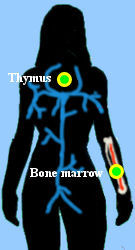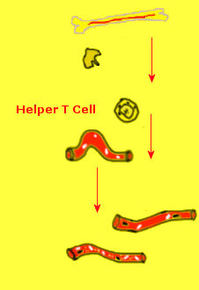The Immune system

Components of the Immune System
Our immune system consists of many components, which all play a part in protecting us from infection. the major components are:
White blood cells the function of these is to protect our body from infections: viruses, bacteria, fungi and parasites. There are many types of white blood cells each with their own role, and whilst some are more important than others it is essential that all cells function correctly.
Lymphocytes are a type of white blood cells. They are an essential part of our immune system. There are various types of lymphocytes: B cells, T helper cells, T-Killer cells and Natural Killer cells.
Important Parts of our Immune System
Our immune system consists of many components, which all play a part in protecting us from infection. the major components are:
- Bone marrow
- Thymus
- Spleen
- Lymphatic system
- White blood cells
- Antibodies
White blood cells the function of these is to protect our body from infections: viruses, bacteria, fungi and parasites. There are many types of white blood cells each with their own role, and whilst some are more important than others it is essential that all cells function correctly.
Lymphocytes are a type of white blood cells. They are an essential part of our immune system. There are various types of lymphocytes: B cells, T helper cells, T-Killer cells and Natural Killer cells.
Important Parts of our Immune System
- Thymus T cells are called "T cells" because they come from the Thymus which is found behind the sternum.
- The Lymphatic System is made up of lymph nodes, liver and spleen linked by fine vein-like channels called lymphatics. Lymphocytes circulate in the blood and lymphatics to and from organs.
- Bone Marrow is a sponge-like tissue inside our bones. T cells along with other blood cells are produced here before going to the Thymus.

T cells are an essential part of what we call a cell-mediated immunity. It is an immune response which does not involve antibodies. B cells produce antibodies.
The development of T cells. T cells originate from bone marrow along with many other blood cells. they then populate the thymus and mature there. Only few cells complete the process and become mature T cells which enter our blood stream and start functioning.
So how do T Cells work?
- First T cells are produced in the bone marrow.
- The Thymus is where T cells mature and after the process is finished they begin to function.
- When a virus or bacteria is encountered, T helper cells are activated.
- They start to divide and rapidly produce protein called "cytokines". This protein will attack infected cells and attract more lymphocytes to fight the infection.
The development of T cells. T cells originate from bone marrow along with many other blood cells. they then populate the thymus and mature there. Only few cells complete the process and become mature T cells which enter our blood stream and start functioning.
So how do T Cells work?
- First T cells are produced in the bone marrow.
- The Thymus is where T cells mature and after the process is finished they begin to function.
- When a virus or bacteria is encountered, T helper cells are activated.
- They start to divide and rapidly produce protein called "cytokines". This protein will attack infected cells and attract more lymphocytes to fight the infection.

The immune system and ATLL
Patients with ATLL have an increased number of T cells in the blood or lymph nodes due to their rapid division and prolonged life. This leads to many problems. Cancerous T cells do not function properly, and this makes the immune system weaker and the patient more susceptible to infections. The presence of this extensive amount of T cells also leads to an increased chance of blood clots, this is referred to as leukaemia which literally means “white blood”.
Patients with ATLL have an increased number of T cells in the blood or lymph nodes due to their rapid division and prolonged life. This leads to many problems. Cancerous T cells do not function properly, and this makes the immune system weaker and the patient more susceptible to infections. The presence of this extensive amount of T cells also leads to an increased chance of blood clots, this is referred to as leukaemia which literally means “white blood”.

An ATLL sufferer may also have a condition called lymphoma. This is when cancerous T cells are only found in lymph glands and due to this, glands increased in size dramatically. Although the blood is normal, the lymph system cannot function properly because all the normal cells are being replaced by cancerous T cells.
